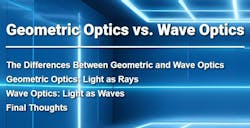Geometric Optics vs. Wave Optics
The Differences Between Geometric and Wave Optics
In the field of optics, a common misunderstanding is the distinction between geometric optics and wave optics. These two approaches describe light in fundamentally different ways. Geometric optics simplifies light behavior by modeling it as rays traveling in straight lines, while wave optics describes light as an electromagnetic wave.
Both approaches are vital depending on the situation. Geometric optics is most useful when dealing with objects significantly larger than the wavelength of light. However, when light encounters very small objects or narrow openings, wave optics becomes necessary to describe how light behaves, focusing on its wave characteristics.
In geometric optics, light’s path is governed by reflection and refraction. On the other hand, wave optics comes into play to explain phenomena like interference and diffraction, concepts that geometric optics does not cover effectively.
This article is the first in the “Avoiding Common Optical Missteps” series, where we’ll break down key topics often misunderstood in optics. Each article will focus on one concept to help you avoid potential pitfalls and improve your understanding of optical theory.
